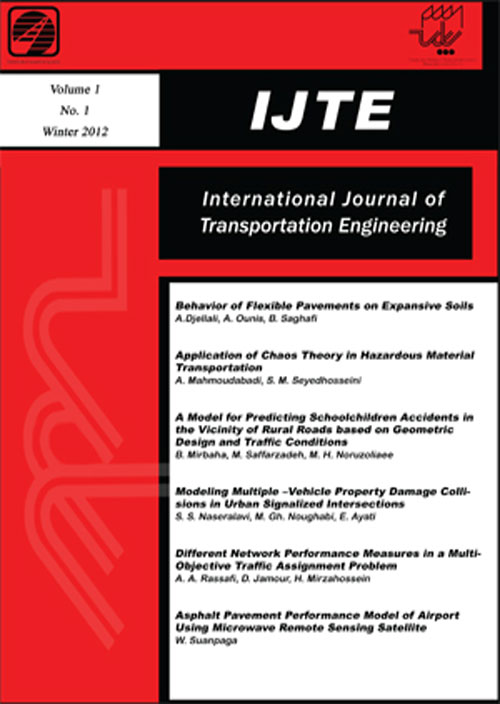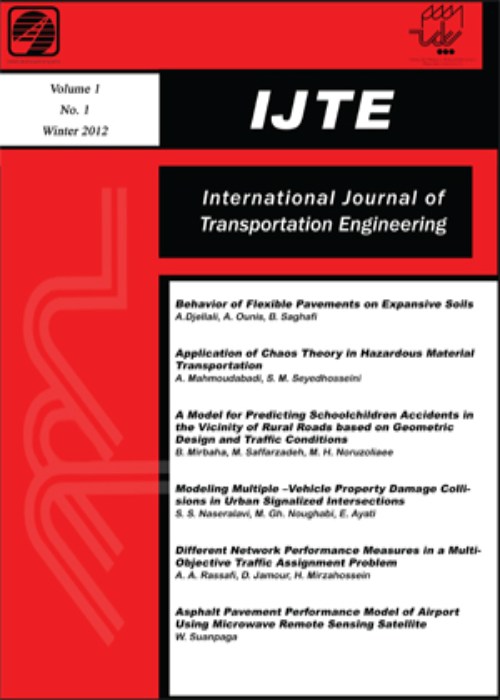فهرست مطالب

International Journal of Transportation Engineering
Volume:10 Issue: 1, Summer 2022
- تاریخ انتشار: 1401/06/27
- تعداد عناوین: 6
-
-
Pages 855-864Despite other modes of transportation, trains move just along one dimension. However, trains inevitably change their track or move to the opposite track in railway stations and ports using switch systems. Switches are vital for better operation and seamless movement of trains. Furthermore, they are crucial for the safety of movement in tracks due to high derailment potentials at switches; therefore, all parts of switches need to be continuously monitored. An increasing number of accidents in railway systems is highly dependent on switch performance. According to the Islamic Republic of Iran Railways, 90 percent of railway accidents in Tehran stations occur on switches, from which 25 percent happen due to switch defects. Therefore, condition evaluation of switches is of significant importance. Research studies have not been sufficiently conducted on automated condition evaluation of switches. This paper aims to develop a robust automated approach to evaluate switch conditions to be able to measure switch defects. Having taken some pictures from various switches with fixed angles and distance from rails, an image processing technique is applied to determine defects. The first step of image processing is to preprocess the images to increase their quality. The second step is to indicate the type and severity of defects using different algorithms. A Graphical User Interface (GUI) is developed to develop a user-friendly tool to be able to load images, preprocess the images, measure defects, and report the health condition of switches. Finally, the outcomes are validated by applying ground truth, which ends up with high accuracy of approximation of 87 percent.Keywords: Fatality Severity, Risk Map, Classification, Decision Tree algorithms
-
Pages 865-875Whenever an accident index exceeds a certain limit, then the critical conditions is created for a spot or section. Accordingly, that spot and section are identified as a hotspot or black spot. Therefore, determining the criterion for critical limits is always one of the essential challenges for traffic safety authorities. The purpose of identifying accident hotspots is to achieve high-priority locations in order to optimally and effectively allocate the safety budgets as well as to promote more efficient and faster safety at the road network level. Obviously, a suitable criterion for communities depends on different factors and parameters such as annual safety budgets, technology level, the amount of trained personnel, community operating strengths, and safety strategic plans and projects. Thus, it is not possible to prescribe a definite and stable criterion for different communities. In recent years, human, vehicle, road and environment have been recognized as the three main effective elements of the road transportation in the occurrence of accidents. In the present study, with combining the parameters related to accidents (including accident time, accident cause and accident severity), geometric parameters of the accident location (including: road width, shoulder width and radius of horizontal and vertical curves, road surface conditions, vertical slopes), and traffic parameters (including: average daily and hourly traffic volume, heavy traffic percentage and average speed), hotspots were identified by using the superior methods of Poisson regression and negative binomial distribution and based on the combined criteria of number and severity of accidents and equivalent damage factors.Keywords: hotspots identification, regression models, number, severity of accidents
-
Pages 877-897Identifying the most important human factors affecting driving violations and the occurrence of high-risk behaviours in driving will help to develop effective and deterrent programs. The aim and contribution of this study was to identify individual, social and environmental factors affecting the incidence of traffic violations by drivers and measure their effectiveness. Through the review of literature, these factors have been identified under variables including cultural capital, demographic variables, individual attitudes (social responsibility and rule of law), lifestyle, environmental factors and citizenship. Studying the effects of variables such as lifestyle, citizenship belonging, social capital distinguishes this paper from others. To measure the effect of variables, a questionnaire was used in which a number of appropriate observed variables were designed for each identified factor. The questionnaires were randomly distributed in the drivers' community of Tehran (248 samples) and after examining the validity and reliability of the research tool, descriptive and inferential statistical analyses including structural equation analysis (partial least squares method) were used to test the research hypotheses. The results of the analysis show that citizenship, attitude, environmental factors and cultural capital have the greatest impact on the rate of traffic violations. Also, the rate of traffic violations in different groups of drivers with different demographic characteristics is different. Planning to improve the attitude and culture of drivers by emphasizing the citizenship factor is one of the ways to reduce the number of violations. The results of this study can help policymakers to design training and tests for reducing traffic violations.Keywords: Traffic violations, Personal Factors, Social factors, Environmental Factors, High-risky Behaviour, Risky Driving
-
Pages 899-918The International North-South Transit Corridor (INSTC) is of prime importance because the economic desirability of international cargo transportation through this corridor can be theoretically much higher than rival routes. Many studies have focused on estimating the cost of transit via the INSTC. Although most of them have sought to collect field information from the status quo of the transportation of the transited cargo, the findings cannot be broken down to each of the rings of the logistics chain. Determining the share of each part of the chain in the total transit cost can help us identify, compare, and remove extra charges and optimize the cost in the entire chain. This paper aimed to analyze the cost breakdown for transported goods from India (Kandla Port) to Kazakhstan (Aktau Port) as a case study route based on the detailed tariffs and rates associated with each logistics activity in each ring of the chain. The findings revealed the high portion of the cost of the maritime sector (49 percent), followed by the land transportation sector (29 percent). Cutting costs in the mentioned sectors is a priority of trade facilitation strategies compared with other parts such as the port sector (22 percent) and custom sector. The results of this research applied to depict a holistic and integrated cost breakdown picture in the INSTC. This study demonstrates how the cost breakdown structure can help managers identify the practical solutions to reduce the transit cost and time.Keywords: International transit, International North-South Transit Corridor, International Trade, Transportation cost, transportation time
-
Pages 919-945
Intelligent transportation system is an effort to reduce traffic, travel time, thereby reducing environmental pollution. One of the solutions to reduce transportation pollution is to make the transportation system smart for users to find the optimal route, because multi-modal transportation plays an important role in passenger movement. It also manages transportation and reduces travel demand. Intelligent transportation systems have made it possible for different sectors to interact with each other. This paper aims to identify contributions of IoT factors in multi-modal mobility to find the optimal path using an umbrella review method. To achieve this, a set of studies focusing on the Internet of Things in multi-modal mobility in different fields were investigated. The sample includes 14 qualitative and 14 quantitative papers. For qualitative papers, conceptual codes were extracted. Then the significance coefficient of each variable was measured using Shannon entropy coefficient. For quantitative papers, after extracting codes and conducting inferential analysis of data using funnel plot, Egger's linear regression, publication bias and heterogeneity Q test, the effect of each of the independent variables along with the dependent variable was measured. Findings reveal that in qualitative papers, "geographical information and timetable for mobility modes" are ranked first and "the amount of electronic facilities and equipment" and "reducing route length and distance" are ranked second. In quantitative papers, the "time to reach destination", "time and volume of traffic", "number of public and private transportation stations", and "reduction in route length and distance" appeared to have a great effect on mobility.
Keywords: Internet of Things, Multi-modal mobility, Optimal Routing, Umbrella Review, Meta-review -
Pages 947-958
Pavement deterioration is a factor contributing to the higher roughness of the road and lower driving comfort in road trips. The pavement roughness measurement has long been an especially important topic to the practitioners. The pavement condition index (PCI) and the international roughness index (IRI) have been applied as two key measures of the quality and performance of the road pavement at the level of project or the road network. Since the pavement condition assessment across a road network by means of the PCI is highly expensive, the present research aims at estimating the PCI based on the IRI to save time and money while evaluating the pavement condition across a road network. For this purpose, we considered three IRI and PCI measurements over main suburban roads in a cold-weather area during a period of 6 years. Firstly, the independence of errors was controlled using the Durbin – Watson statistic, followed by evaluating the normality of the data using the Kolmogorov – Smirnov and the Shapiro – Wilk tests. In order to measure the correlation of the normal data, we used the Pearson’s tests. Results of regression analysis between IRI and PCI showed that the best equation describing their association is a linear inverse model with an R2 = 0.992. A statistical comparison was made between the observed and predicted PCI values and model developed in the present research was further compared to similar research works, exhibiting acceptable agreement of the results.
Keywords: PCI, IRI, Regression Model, Road, Deterioration


